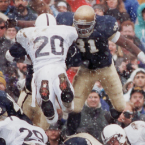NCAA Proposes Rule Changes -- Targeting and Defensive Substitution
-
Topics
-
Posts
-
By FaithInIrish Forever · Posted
Sorry guys I bumped enter before I finished. Is it playoff or bust for you? Ideally the offense would be in year 2 under Denbrock but if we temper expectations to '25 the defense is younger. -
Deuce has just won the On3 MVP award for the OT7
-
Singer has crystal balled Faraimo to ND now…
-
By FaithInIrish Forever · Posted
I'm hearing pIlayoff or bust I'm hearing host and win a home playoff game A season hasn't been this hyped in 12 years. Even Kelly in year 3 came as a surprise to many. The hype train started for me when they hired Denbrock away from LSU for four years. Signed Al Golden for four years Kept Chad Bowden Defense Returns Key players. Third different offense in 3 years Kickers are like a revolving door. Schedule looks winnable (opener really matters)
-






Recommended Posts
Join the conversation
You can post now and register later. If you have an account, sign in now to post with your account.